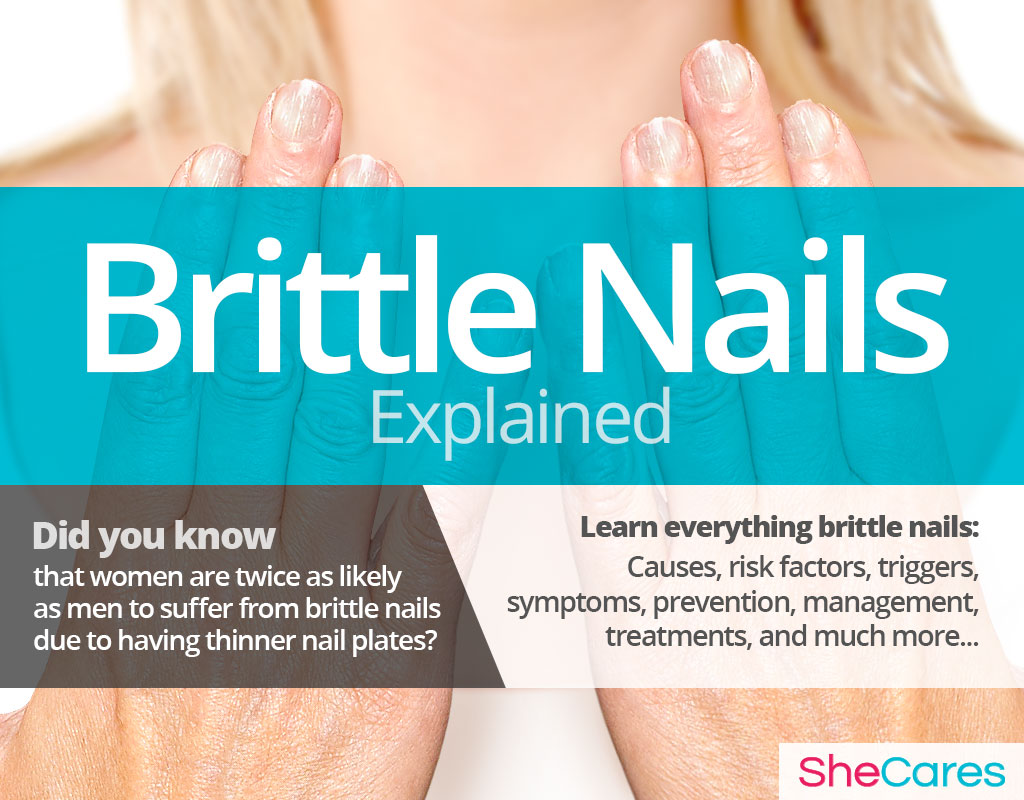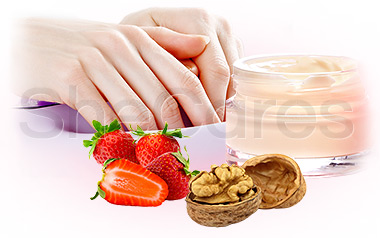About
What Are Brittle Nails?
Quick Facts about Brittle Nails
- Brittle nails affect about 20% of the population.
- Women are twice as likely to suffer from brittle nails as men, due to thinner nail plates.
- Onychoschizia, or the splitting of nail layers, affects between 27-35% of adult women.
Fingernails and toenails grow from the nail matrix, which is found under the cuticle and the lunula, the white semicircle at the base of the nail. The cells in the nail matrix produce keratin, a fibrous protein, and as these cells die, they are pushed upwards and outwards by new cells, forming the nail plate. Nails will grow strong and steady so long as the body is healthy. However, if nails change in color or texture, becoming weaker or more brittle, this may reveal a disease, nutrient deficiency, or hormonal imbalance that is inhibiting the production of keratin.
Around a third of women will develop brittle nail syndrome at some point during their reproductive lives. One of the most common types of brittle nails among women is onychoschizia, or the horizontal splitting and peeling of nail layers. For many of these women, the cause could be as simple as hormonal imbalance. Women are more likely to suffer from extreme hormonal fluctuations during certain stages of reproductive life, such as puberty, pregnancy, post-partum (including breastfeeding), and menopause. This can lead to disorders, such as brittle nails, or other changes in nail appearance.
Identifying Brittle Nails
There are many different types of nail disorders, and most of them have distinctive signs and symptoms that signal a variety of causes. However, brittle nails appear otherwise normal apart from their tendency to split or break easily. Brittle nails can be categorized by their severity and the frequency of their breaking.
Other Nails Problems
There are many different types of nails problems. These are:
Most of these health disorders have distinctive signs and symptoms as well as a variety of causes.
Continue reading to discover the main hormonal and non-hormonal causes of nail brittleness.
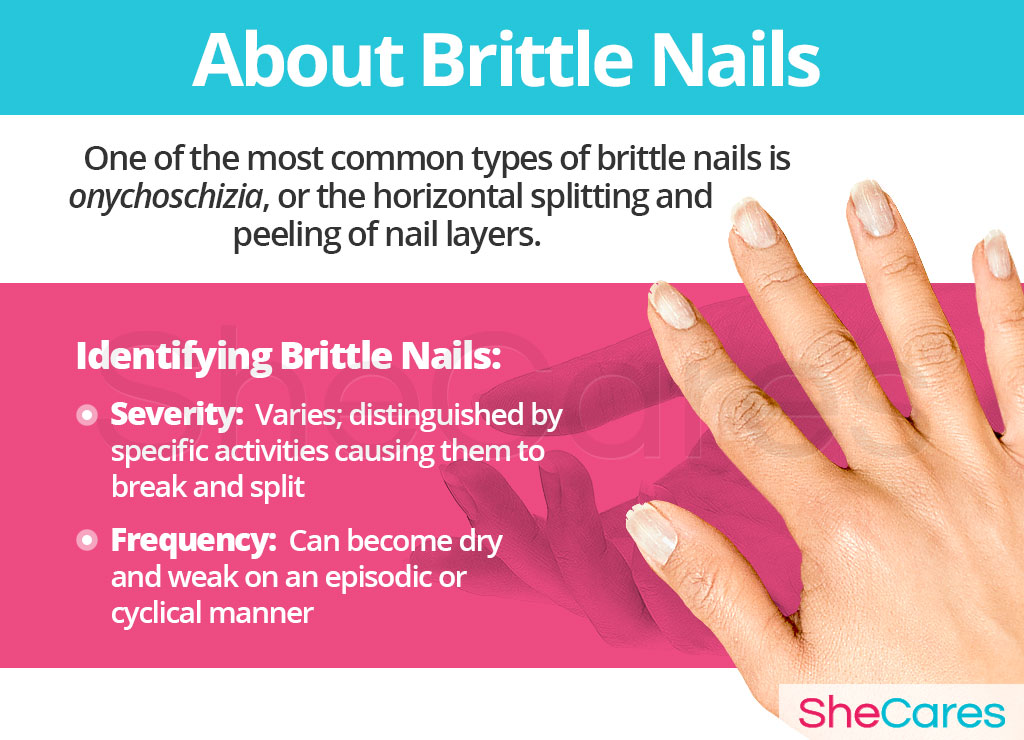
Causes
Reading about the causes of brittle nails will help women understand how to prevent this condition from occurring. While nail disorders can arise for a variety of health and environmental factors, the increased prevalence of brittle nails among women can be explained by hormonal causes. In addition, other underlying health conditions or behaviors may also have an impact on the development of brittle nails.
Continue reading to learn more about both the hormonal and additional causes of brittle nails.
Hormonal Causes of Brittle Nails
Hormones are chemical messengers that control every process in the body. When hormone levels fluctuate, these processes can go awry, causing conditions like brittle nails. Estrogen, one of the reproductive hormones, is responsible for water retention in the body; therefore, low levels lead to dehydration. Approximately 10-15% of the nail contains water. So, dehydration caused by estrogen deficiency also affects nails, leading to weak, dry, split, or brittle nails.
Estrogen deficiency is common during phases of significant hormonal imbalance during a woman's reproductive life, including puberty, pregnancy, post-partum, and menopause. Although brittle nails can occur at any time, women undergoing these hormonal changes may find that they are experiencing unprecedented changes in nail appearance.
In addition to hormonal causes, each stage of a women's reproductive life may have its own related factors which may explain the occurrence of brittle nails.
Hormonal Causes during Different Phases in a Woman's Life
Puberty is the stage in which a girl's body begins to produce reproductive hormones; these and other factors, such as the consequences of stress from school and dating pressures, contribute to brittle nails during puberty.
Pregnancy leads to extreme changes in the production of reproductive hormones, which along with other factors, like fatigue or bodily changes, can lead to brittle nails.
Post-partum and breastfeeding is another stage where reproductive hormones are imbalanced, leading to symptoms like brittle nails. Also, other factors contribute to brittle nails in post-partum, like post-partum depression.
Menopause is the stage in a woman's life when production of reproductive hormones naturally declines, signaling the end of a woman's fertility. As well as hormonal causes, other factors add to the reasons for brittle nails during menopause.
Other Less Common Causes of Brittle Nails
Hormonal imbalance most commonly accounts for the increased incidence of brittle nails among women as opposed to men. However, brittle nails could be caused by other, less frequent factors such as anemia, malnutrition, or thyroid conditions.
Now that all the causes of brittle nails have been outlined, keep reading to discover what risk factors and triggers influence women's chances of developing the condition.
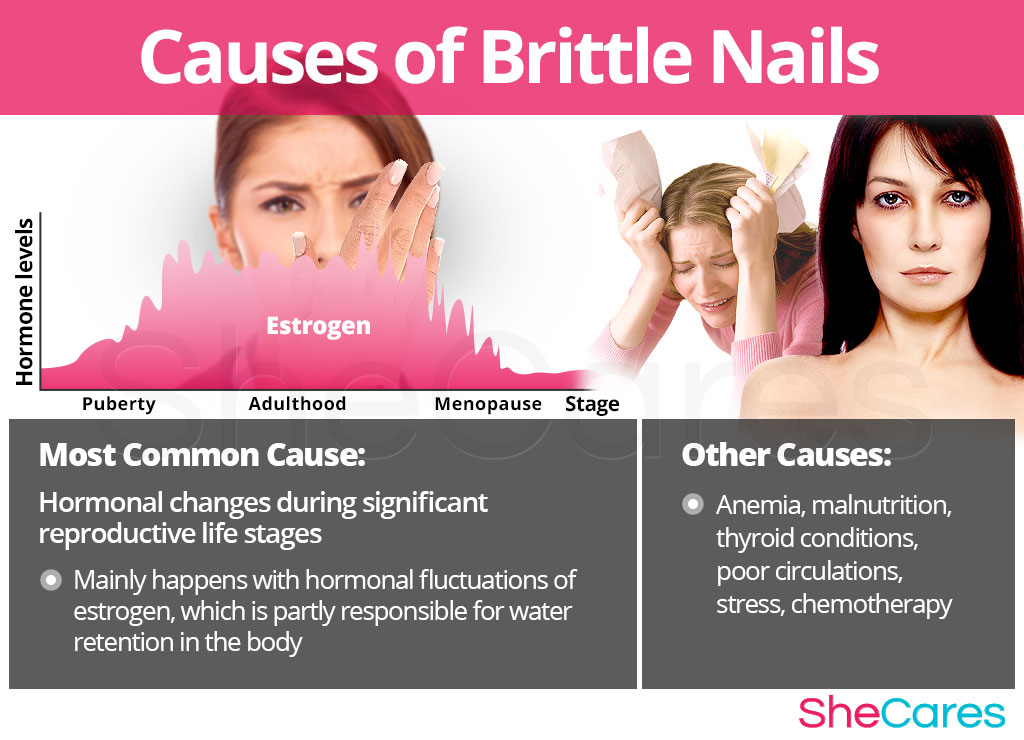
Risk Factors and Triggers
Risk Factors of Brittle Nails
There are many factors which may influence the chances of developing brittle nails.
- Long nails. The longer nails are, the more likely they are to snap, snag, or break.
- Office jobs. Tapping or typing causes a series of mini traumas to the nail plate, which can lead to brittle nails.
- Biotin deficiency. Biotin, or vitamin B7, is an essential vitamin for healthy nail growth; therefore, women with a biotin deficiency are much more likely to develop brittle nails.
Triggers of Brittle Nails
As well as the pathological causes of brittle nails, certain environmental factors and behaviors can trigger symptoms of this condition. Therefore, avoiding these triggers may reduce the likelihood of developing brittle nails or damaging the nails. These triggers include habits such as biting nails or using them as tools as well as environmental factors like exposure to chemicals.
Keep reading to discover the signs and symptoms of brittle nail syndrome in order to identify this nail condition over others and be able to choose an apt treatment.
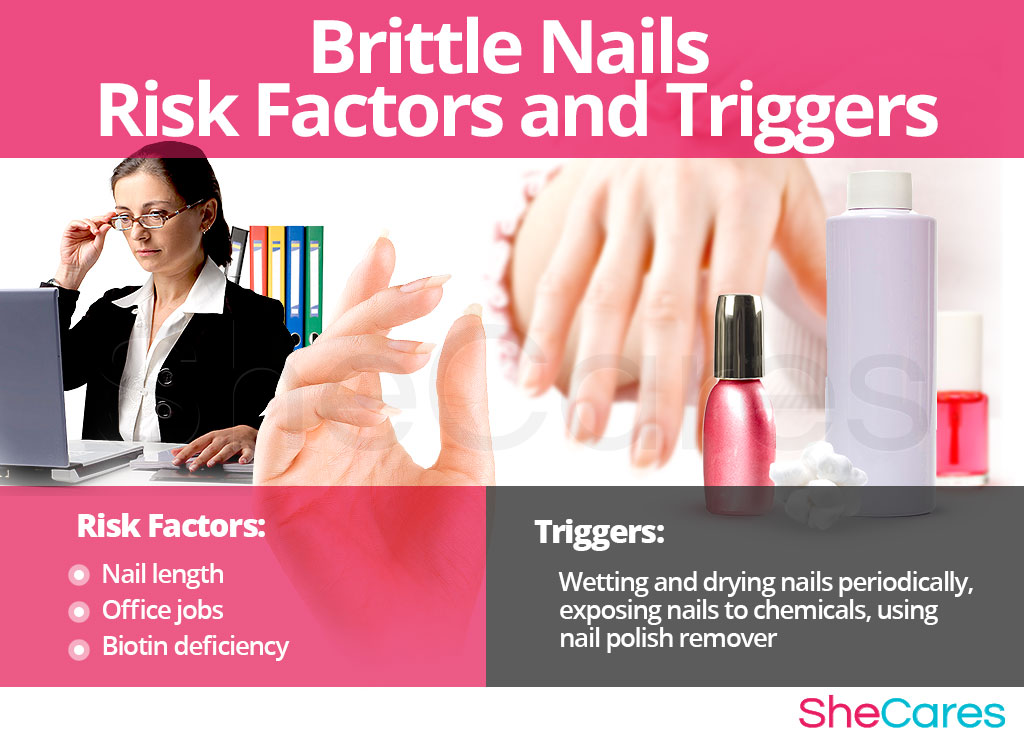
Signs and Symptoms
Brittle nails can manifest in many different ways. So, each woman will experience the symptoms of brittle nails differently. However, there are some common nail symptoms that women suffering from hormonal imbalances are likely to develop.
Symptoms of Brittle Nails
- Dry nails
- Weak, soft, or thin nails
- Nail tips that split or peel off
- Nails that break or chip easily
- Symptoms present in fingernails and toenails
Signs of Brittle Nails
The key way in which a doctor will be able to diagnose brittle nails as a consequence of hormonal imbalance is by comparing the nails on the hands and feet. If it is only the nails on the hands that are experiencing brittleness symptoms, it is likely that this is due to environmental triggers; whereas, if the toenails also present signs of brittleness, then this will suggest a more serious underlying cause, like estrogen deficiency.
Diagnosis of Brittle Nails
To diagnose the cause of brittle nails, a doctor will first review a patient's medical history and lifestyle choices, then perform a physical exam of the nails on the hands and feet, and finally do a psychological evaluation to assess stress factors. Tests may be ordered if necessary.
Related Nail Conditions and Their Warning Signs
There are many other nail disorders that may be confused with brittle nails, which also present changes to the appearance of the nails. These conditions, such as nail clubbing or the detachment of the nail from the nail bed, may be symptomatic of more serious vitamin or mineral deficiencies or health conditions, including heart and lung disease.
Warning Signs of Related Nail Conditions
- Thickening of nail at tip
- Ridges or pitting of nail plate
- Discoloration of nail
- Loosening of nail
- Sinking, curving, or curling nail
- Pale nail with a blue or purple lunula
Nails are a good outward indicator of any underlying problems there might be in the body. So, if any of these symptoms or warning signs occur, then it is important to seek the advice of a medical professional.
Brittle nails are a nuisance for women who suffer from this condition, so it is worth learning some ways to prevent nails from becoming brittle. Continue reading for useful habits or tips for nail care routines in order to prevent brittle nails or make them more manageable if the disorder occurs.
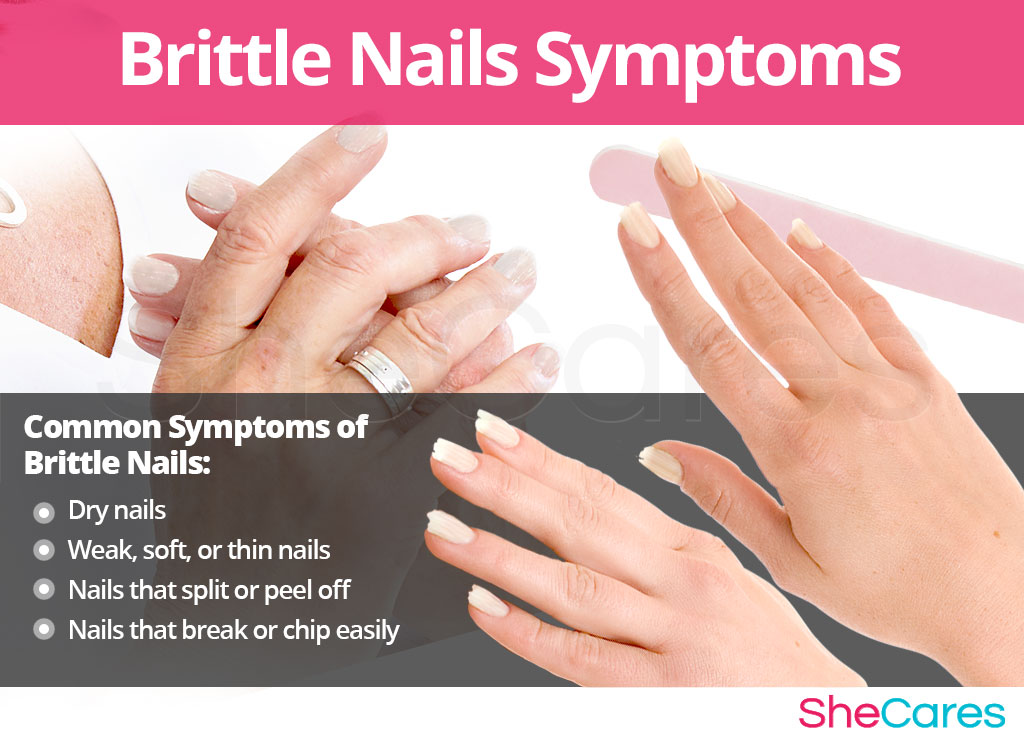
Prevention and Management
Preventing Brittle Nails
There is no surefire way to prevent brittle nails; however, there are certain techniques women can use, or habits that be developed, which will reduce the chances of nails becoming brittle or minimize breakages. These consist of a combination of lifestyle changes to improve vitamin and mineral intake and circulation via positive changes to diet, exercise, and healthy habits as well as the use of supplements to enhance the endocrine system and, therefore, help prevent brittle nails caused by hormonal imbalance.
For women who are already suffering from brittle nails, prevention may no longer be possible. Fortunately, there are many ways to manage them in order to prevent any painful injury or further disruption of daily activities. Keep reading to learn about practical tips to manage brittle nails.
Managing Brittle Nails
For women who are prone to brittle or weak nails, there are management techniques available that can help improve nail appearance and reduce the likelihood of nails splitting off or breaking. Some general tips that women of all ages can use include keeping nails short and soaking nails in oil.
These management techniques work for some women to make their nails appear healthy again, but if the brittle nails are caused by an underlying condition, such as a hormonal imbalance, rather than purely environmental factors, then they will do little to fix the root of the problem. However, there are several treatment options available that will help treat the hormonal causes of brittle nails. Continue reading to discover these approaches to brittle nails treatment.
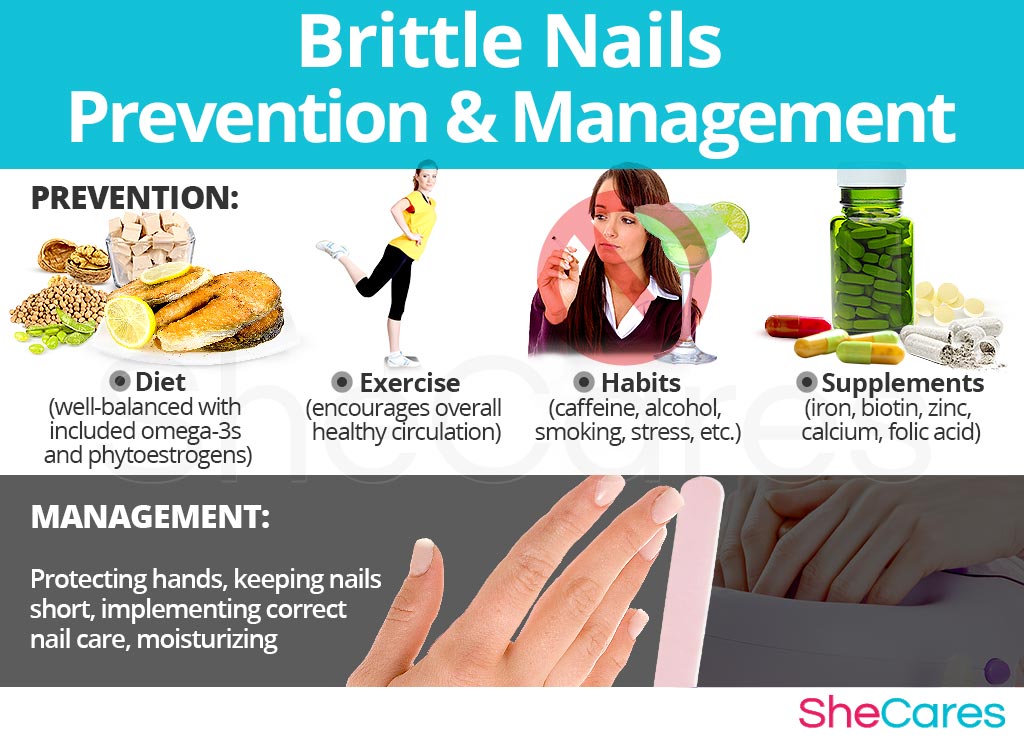
Treatments
Brittle nails, a symptom and a noticeable sign of hormonal imbalance, can be a nuisance, but for some women, they can be embarrassing, affecting self-esteem with possible pain involved. Fortunately, there are many effective treatments that women can turn to in order to combat brittle nails.
Three Approaches to Treat Brittle Nails
Three levels of approaches can be considered for treating brittle nails. These are categorized as: (1) Lifestyle Changes, (2) Alternative Medicine, and (3) Pharmaceutical Options.
Because estrogen deficiency is one of the most likely causes of brittle nails in women, it is vital to ensure that the endocrine system is functioning to the best of its capability. Women are encouraged to begin with the least risky approach to treatment, lifestyle adjustments, and then proceed to the next level of care. While medical intervention is not usually necessary to treat brittle nails, some women who are unable to find relief from lifestyle changes and alternative medicine may wish to consider pharmaceutical options, after properly assessing the risks associated with such a treatment.
Lifestyle Changes for Brittle Nails
This primary level of treatment involves the least amount of risk, though conversely, it requires the highest amount of self-discipline. Often, simple changes in lifestyle can reap huge benefits in curing brittle nails and achieving a higher overall level of health. Fundamentally, an improved diet, regular exercise, and healthy habits can do a woman great service.
These lifestyle changes are effective and necessary for the treatment of brittle nails; however, they do not treat hormonal imbalance directly. Instead, alternative medicine is an excellent solution to brittle nails caused by hormonal imbalance. This can be used in conjunction with lifestyle changes to banish brittle nails in a safe and natural way.
Alternative Medicine for Brittle Nails
Alternative medicines and supplements involve little to no risk and can be an extremely effective way to treat brittle nails. In the case of herbal supplements, there are two main types that can be used: phytoestrogenic and hormone-regulating herbal supplements.
Phytoestrogenic herbal supplements
These supplements, such as black cohosh, contain estrogenic components produced by plants that complement the low estrogen hormones in a woman's body, helping treat brittle nails. By introducing plant-based estrogens into the body, these herbs treat the underlying estrogen deficiency behind nail problems.
They are mainly effective for menopausal women who are more likely to have low estrogen levels but are not necessarily effective for women in other stages of life, such as puberty.
Hormone-regulating herbal supplements
These supplements, including Macafem stimulate the body's natural hormone production by nourishing the pituitary and endocrine glands, helping the whole hormonal system produce hormones more efficiently. This ultimately results in balancing not only estrogen, but other important hormones such as progesterone.
These supplements can be considered the safest and most natural way to treat the underlying hormonal imbalance behind brittle nails and can be taken throughout a woman's life as they support the body's natural hormone production.
Additionally, there are some other types of supplements that can also alleviate brittle nails or at least make them more manageable, including vitamins and other herbal supplements.
A combination of lifestyle changes and alternative medicine is often the most effective way to treat brittle nails. However, if brittle nails are a symptom of a more serious hormonal imbalance, such as during menopause, some women may decide to turn to more drastic treatment.
Pharmaceutical Options for Brittle Nails
Pharmaceutical options are often the riskiest and most expensive form of treatment. In the case of brittle nails, hormone-regulating medication is one of the only available for women whose hormonal imbalance results from perimenopause or menopause.
Different treatment options will suit different women at different stages of their lives, and a combination of these approaches can be used to treat brittle nails throughout reproductive life depending on the duration and severity of symptoms. Nowadays, women are increasingly finding that the ideal treatment for symptoms of hormonal imbalance involves healthy lifestyle changes complemented by alternative medicine.
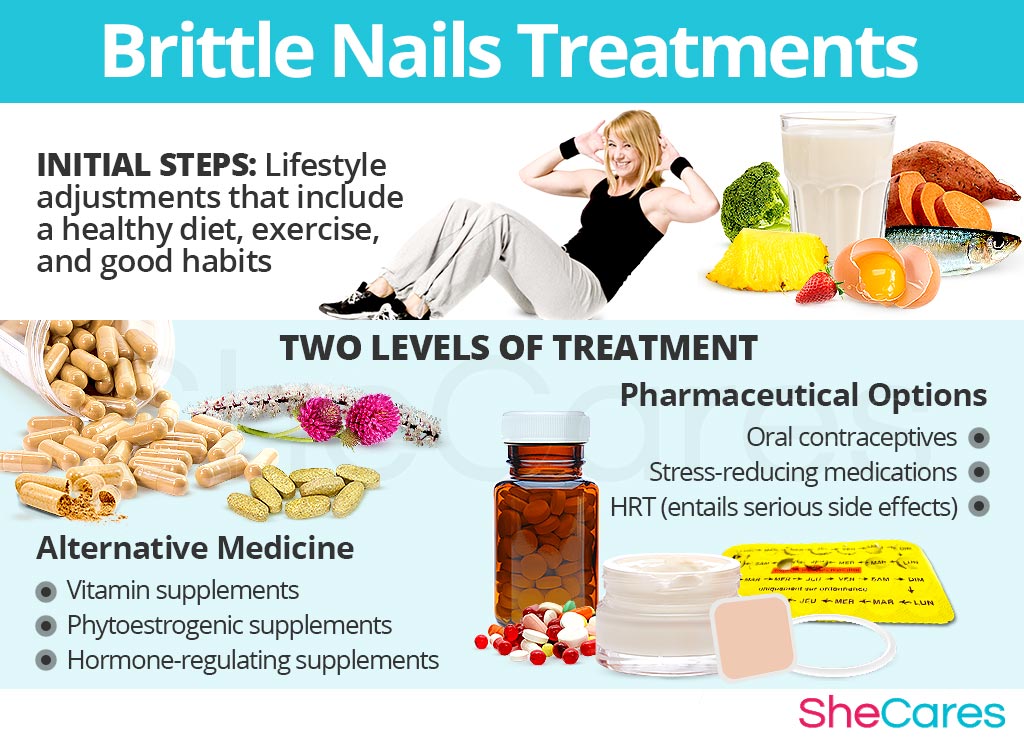
Sources
- MenopauseNow. (n.d.). Brittle Nails. Retrieved November 2, 2017, from https://www.menopausenow.com/brittle-nails
- American Osteopathic College of Dermatology. (n.d.). Brittle Splitting Nails. Retrieved November 2, 2017, from http://www.aocd.org/skin/dermatologic_diseases/brittle_splitting.html
- Leung, A.K. & Robson, W.L. (1990). Nailbiting. Clinical Pediatrics (Philadelphia), 29 (12), 690-692. Retrieved November 2, 2017, from https://www.ncbi.nlm.nih.gov/pubmed/2276242
- Sparavigna, A. et al. (2006). Equisetum arvense in a new transungual technology improves nail structure and appearance. Journal of Plastic Dermatology, 2(1), 31-38. Retrieved November 2, 2017, from https://www.researchgate.net/publication/258027706_Equisetum_arvense_in_a_new_transungual_technology_imporves_nail_structure_and_appearance
- Utah Department of Health. (n.d.). Anemia. Retrieved November 2, 2017, from https://mihp.utah.gov/during-pregnancy/anemia
- Van de Kerkhof, P.C., et al. (2005). Brittle nail syndrome: A pathogenesis-based approach with a proposed grading system. Journal of the American Academy of Dermatology, 53(4), 644-651. Retrieved November 2, 2017, from https://www.ncbi.nlm.nih.gov/pubmed/16198786
